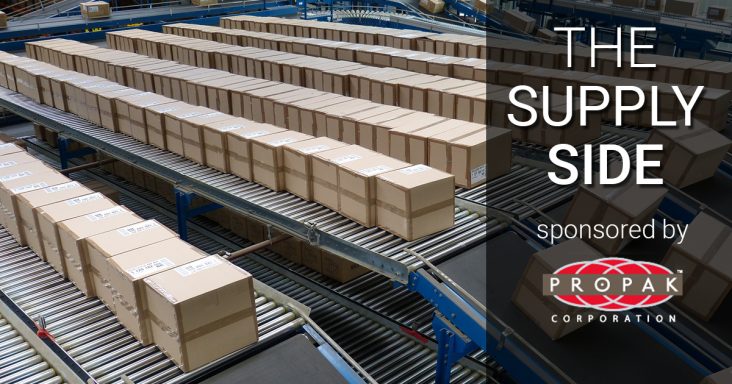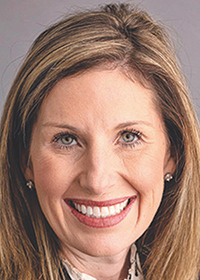The Supply Side: Walmart exec Julie Barber talks retail inventory issues, inflation
by December 27, 2022 9:47 am 2,851 views

Julie Barber, Walmart’s executive vice president of general merchandise, said the retailer continues to face an overabundance of inventory in some categories and inflationary pricing pressures.
She said the company hopes to mitigate the issues with the help of its suppliers.
Barber spoke on Dec. 1 as part of the Greater Bentonville Area Chamber of Commerce’s WalStreet Speaker Series. She is two months into her newest job at Walmart after nearly 19 years with the retail giant. Before overseeing all of general merchandise, she was a merchant and category director over consumables and worked in the health and wellness division during the COVID-19 pandemic.
After graduating from the University of Arkansas, she worked in financial services as an analyst in her first job at Walmart. Barber said she’s a merchant at heart and hopes her years in consumables and studying consumer behaviors will give her added perception into managing discretionary categories.
She said Walmart has streamlined the management of general merchandise categories of toys, seasonal, home appliances, entertainment and hardlines such as hardware, sporting equipment and outdoor under one team leader. She now oversees all of these categories’ sales in-store and online.
“We consolidated the leadership to run faster and try to find synergies by eliminating duplication,” Barber said. “We are also working to share talent better between consumables and general merchandise. We are also working on determining the best place in the store where customers can find a certain item. Right now, we have some items that are sold on the grocery side and also on the general merchandise side of the store. We seek to eliminate that duplication without disrupting sales.”
She said having the same item located in several positions in the store makes it more difficult for the search function to work, and then there is the question of who owns and is responsible for the online content.
Barber said she has four primary areas of focus that have served her well in the past. She said Walmart must nail the fundamentals during more challenging economic times. Having all the general merchandise departments consolidated under her leadership required transparency and proactive communication.
“For the past two years, we could sell anything and everything we bought as consumers had stimulus money to spend, and they largely were homebound in the first year of the pandemic. In March of this year, that rush to buy just stopped overnight. We were left with merchandise that didn’t sell right away, and it’s taken some work to move through the excess inventory we had in March,” Barber said.
Walmart has reported inventory overruns of 32%. Walmart began to slash prices in March, and by the end of the third fiscal quarter in October, the retailer said it was still sitting on $1 billion in excess inventory or 12% more than expected.
Barber said she has some inventory in dark storage that comes with an interim cost, but she has opted to reintroduce seasonal merchandise in early 2023 without too much of a markdown. She sought to hold on to some, discount and sell through some items so she could continue to place new orders. The third area of focus is working with suppliers to fight inflation.

“I want to partner with suppliers to help us fight inflation by removing inefficiencies from the system. I know that Walmart, at times, has put in processes that add to supplier costs, and I also know suppliers have their own inefficiencies. If we can work together to try and pull out those costs, we may keep prices lower for customers in these challenging economic times. I believe inflation will be around through [2023], and we will have to work to keep from raising prices,” Barber said.
She said Walmart is seeing lower ocean freight costs, but there are still rising cost pressures because of raw material costs. She warned suppliers to only bring her price increases with a plan to negotiate. She also urged suppliers to get her their full product catalogs so Walmart can continue to add to its online merchandise. She said the retailer is reevaluating the best way for suppliers to ship products to remove costs from the supply chain. Barber said suppliers might be asked to ship directly to stores in some cases where it makes more sense to use the stores for fulfillment.
Barber said if Walmart can nail the fundamentals and work with suppliers to keep prices down, customers will be served at a time when they need a little help. She said her fourth area of focus is working together for the greater good.
Barber said her team monitors the Walmart.com experience daily during the holiday shopping season to be up-to-date on how sales resonate with consumers.
“We review what’s on the site and how the site performs for the day. We adjust the offerings each day so that consumers can see more products. We continue to work on improving search,” Barber said.
She also told suppliers to subscribe to Walmart’s Luminate data services platform because it helps provide detail on product sales.
“I use it all the time and can vouch that the insights it provides can enhance your business. I am still a fan of Retail Link, but the Luminate data goes way deeper to help you grow your business,” Barber said.
Barber said Walmart continues to look for stable manufacturing alternatives to China with well-publicized efforts to buy American and also ramp up purchases from manufacturers in India.
“We want to buy quality items for our customers at a value and will continue to explore manufacturing outside China in the foreseeable future,” she said.
Editor’s note: The Supply Side section of Talk Business & Politics focuses on the companies, organizations, issues and individuals engaged in providing products and services to retailers. The Supply Side is managed by Talk Business & Politics and sponsored by Propak Logistics.
